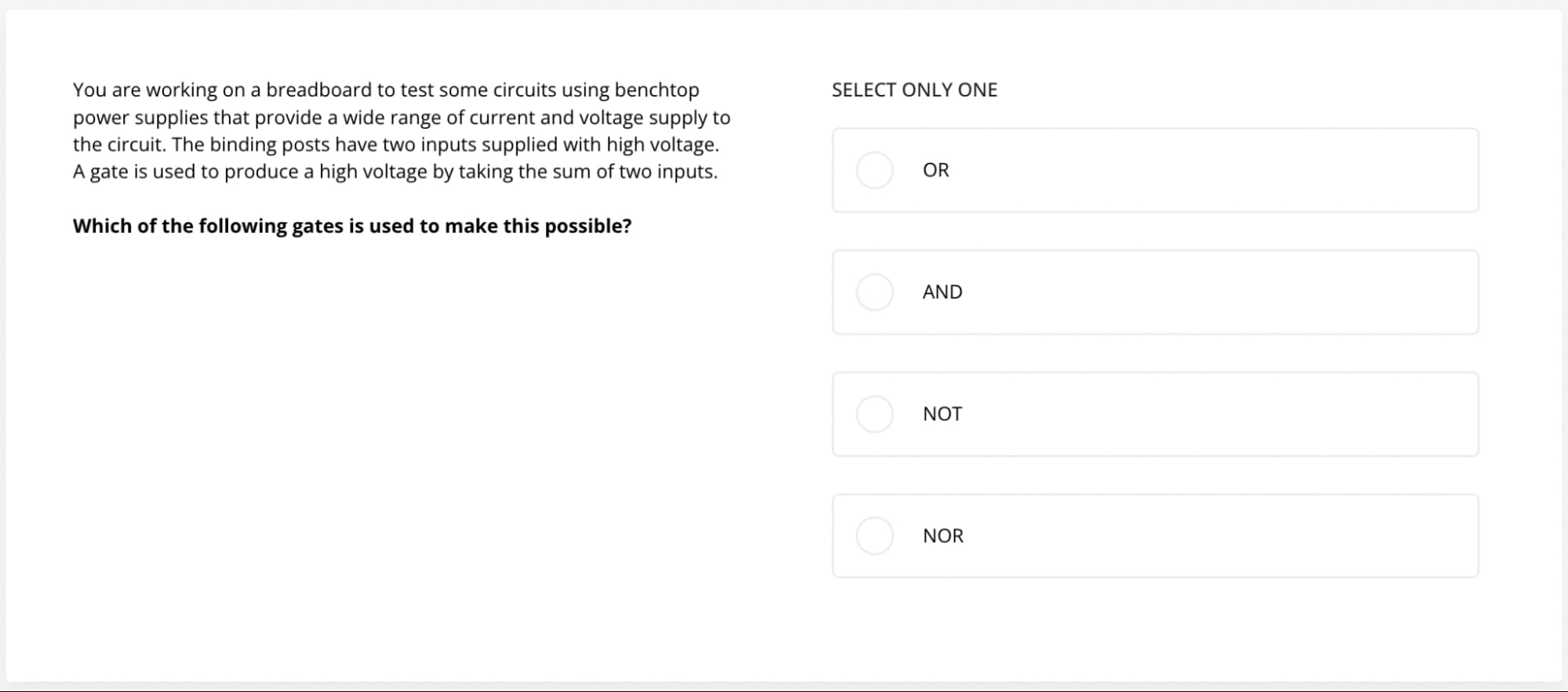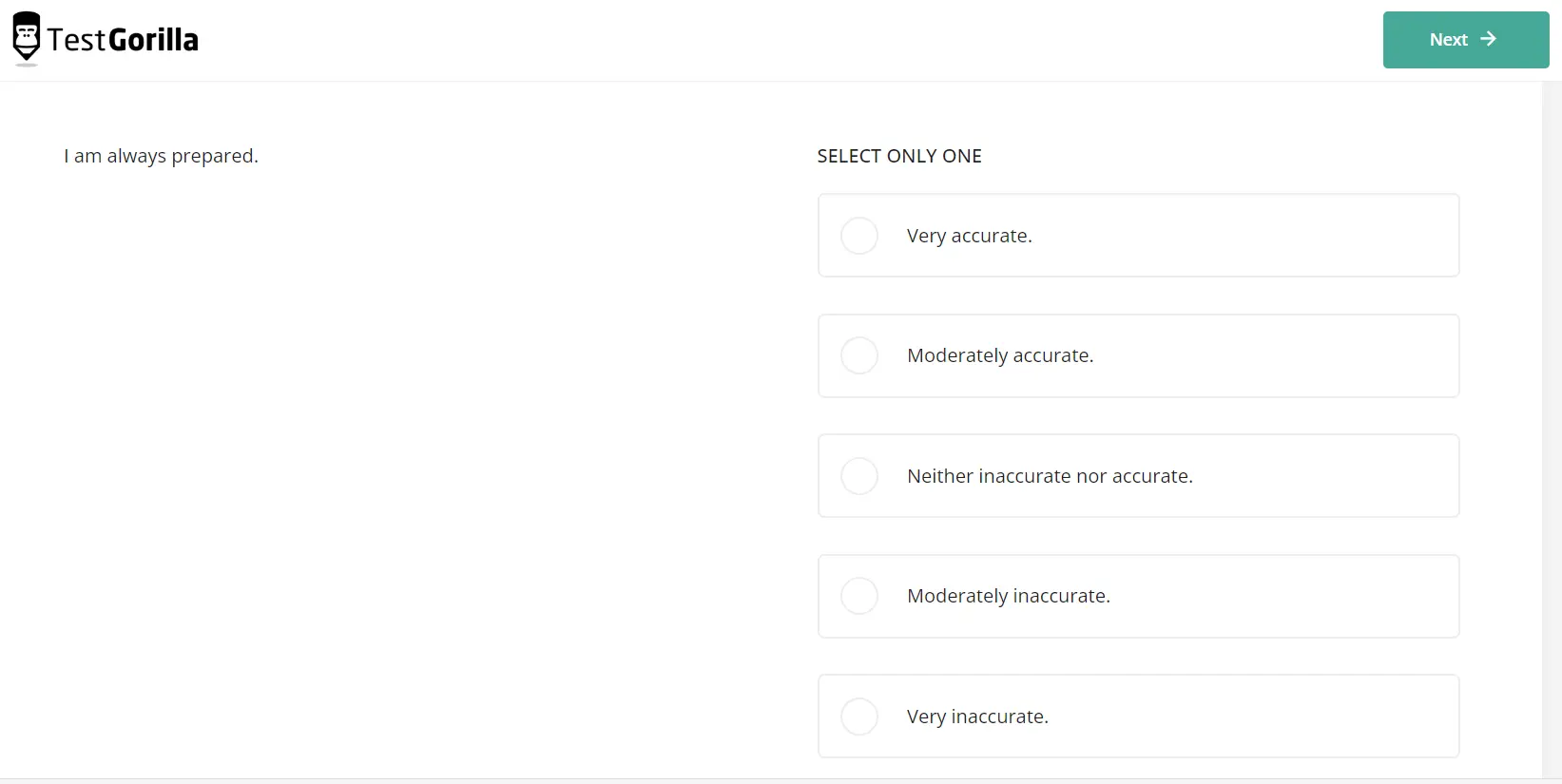How to ensure a great person organization fit: A 7-step hiring guide
Ignoring person-organization (PO) fit impacts team dynamics and undercuts company goals. The ripple effect of these mismatches disrupts employee productivity and morale, posing significant challenges for your business.
That’s why you need to assess PO fit to ensure you hire people who get along well with their future colleagues, peers, and managers. Finding a strong organizational fit also improves your company’s employee retention rates.
In this article, we explore why hiring a good person-organization fit makes such a big difference, explain how to optimize your hiring process with talent assessments, and outline the pitfalls to avoid in your recruitment strategy.
Table of contents
- What is a person-organization fit?
- The benefits of hiring for strong P-O fit
- The issues with hiring staff with poor person-organization fit
- 7-step guide on ensuring person-organization fit when hiring new employees
- The possible problem with person-organization fit and how to resolve it ethically
- Find the perfect person-organization fit with TestGorilla
- Person-organization fit FAQs
What is a person-organization fit?
Building on Chatman’s original definition, person-organization fit is the alignment between an individual’s values, beliefs, and behavior and an organization’s culture, values, and goals. This compatibility means employees share and contribute positively to company culture. Assessing PO fit is an employee recruitment strategy companies use to analyze whether an employee is compatible with the organization.
It is crucial for employee satisfaction, engagement, retention, and organizational commitment having strong, positive correlations with each of these factors.
What is a person-job fit?
Person job fit is the alignment between an individual’s abilities, skills, and interests and the specific demands, responsibilities, and expectations of a job. It ensures employees are qualified and skilled enough to do their jobs, which leads to higher productivity, performance, and job satisfaction.
Job fit assessment is quite objective – candidates either possess the skills and attributes to do the job or don’t.
So, if you are looking to hire a software engineer, you want to know if they can write quality code. Similarly, if you are hiring an email marketer, you should be confident they can write email copy.
However, there are some problems with this hiring approach.
Person-job fit, person-organization fit, or both?
A person to job fit was the main way to hire employees before the 2000s.
However, companies soon realized that only looking at the person-job fit when hiring candidates wasn’t enough. Some people had all the right skills for a specific job but were a nightmare to work with.
As a result, hiring managers quickly adapted their approach and started assessing whether applicants had values and outlooks that matched the company’s values.
So, which approach is better?
Person-job fit and person-organization fit aren’t mutually exclusive. You should always evaluate core skills for the role. But you also need skillful people who can contribute to your company’s culture.
The benefits of hiring for strong P-O fit
Although many potential candidates have skills suited to a specific role, not everyone makes a great employee. That's why you need to hire a strong PO fit.
Here are some of the benefits of hiring for an excellent person-organization fit:
Higher job satisfaction: Workers who are a good person to organization fit tend to find more meaning and fulfillment in their work, resulting in positive outcomes like higher satisfaction, which is backed up by Kristof-Brown’s meta-analysis of P-O fit.
Better employee performance: Employees who fit well with the organization are more likely to understand and embrace its goals, leading to high performance and productivity. This goal alignment leads to 50% higher engagement.
Increased employee retention: Employees who strongly connect with the organizational culture and values are more likely to remain with the company, leading to lower attrition rates.
Reduced workplace conflict: A good fit between employees and the organization leads to fewer workplace conflicts and less job-related stress. Coworker conflict is the main negative job experience for 40% of people, so it’s important to avoid it.
Higher team cohesion: A strong P-O fit contributes to a more harmonious workplace that supports a collaborative environment and improves teamwork.
Better corporate culture: Around 46% of job seekers find company culture important, so evaluating person-organization fit attracts more like-minded candidates.
If you want to explore the advantages of using TestGorilla’s talent assessments to find the best person-organization fit, book a quick live demo.
The best insights on HR and recruitment, delivered to your inbox.
Biweekly updates. No spam. Unsubscribe any time.
The issues with hiring staff with poor person-organization fit
Hiring someone who is a poor person-organization fit can negatively affect your organization. Here are the main problems:
Issue | Impact |
Lower productivity | Lack of engagement, missed deadlines, poor work quality, and lack of efficiency. |
High employee turnover | Employee dissatisfaction and voluntary turnover. |
Reduced team morale | Feelings of alienation and discontent impact the overall team morale and workplace atmosphere. |
Frequent workplace conflict | Disrupted workflow, poor communication, and low morale. |
Ineffective collaboration | Reduced project success and innovation, and poor adaptation to market changes. |
Compromised company reputation | Misrepresentation of the company’s values, inconsistent customer experiences, and potential reputation damage. |
Additional resource spending | Poor P-O fit employees require additional training, supervision, and HR interventions and initiatives, diverting resources from other priorities. |
7-step guide on ensuring person-organization fit when hiring new employees
Securing a good person to organization fit is crucial for long-term employee wellbeing and organizational success.
Here’s how to navigate assessing PO fit to ensure individual and company values align.
Hiring for strong person-organization fit: The summary
Step | Benefit |
1. Define company values | Establishes a clear company culture, which attracts like-minded candidates |
2. Include your company’s values in the job description | Clarifies expectations and culture to potential candidates, ensuring only those aligned with these values apply |
3. Build an employer brand | Attracts those who are a natural cultural add |
4. Screen candidates with talent assessments | Provides objective insights into candidates’ skills and personality traits, ensuring a person-organization and person-job fit |
5. Interview shortlisted candidates | Supports additional evaluation of the candidate’s alignment with company values through structured, bias-free discussions |
6. Onboard new hires | Integrates new employees into the team, which reinforces their connection and fit with the organization |
7. Re-evaluate the person-organization fit | Re-assesses alignment and integration, enabling timely adjustments to improve satisfaction |
1. Define company values and desired employee behaviors
Defining company values guides behaviors, decision-making processes, and the overall direction of your business. Well-defined organizational values help attract like-minded people with the necessary skills and competencies.
So, how do you define company values?
Consider the underlying principles driving your business objectives and how you want your organization to be perceived by employees and the external community.
Involve key stakeholders in the process, including leadership, employees, and even customers. This inclusive approach ensures your defined values genuinely represent your organizational psychology and culture.
Lastly, identify behaviors that exemplify success within your organization. Consider actions and work attitudes that contribute to your company’s achievements and goals.
Incorporate these values and desired behaviors into your branding, internal communications, and human resources practices to embed them into the fabric of your organizational culture. That includes recruitment, onboarding, and performance evaluations.
2. Include your company’s values in the job description
To guarantee a good person-organization fit, it’s important to include the company’s values in the job description.
This practice means potential employees clearly understand what the company stands for and what it expects from its employees. In addition, it should drive away any candidates who don't match your values.
That’s why you should start each job description with a brief section about your company, emphasizing core values. This sets the tone for the recruitment process and signals the importance of value congruence to potential applicants.
Another good idea is to integrate your values into the description of job responsibilities and expectations. For example, if teamwork is a core value, explain how the role contributes to the overall collaborative culture.
Lastly, align the required skills with your values. So, if innovation is a key value, specify the need for creative thinking or problem solving skills.
3. Attract and build an employer brand
After you write the job description, it’s time to publicize that open role on job boards. To do so, you shouldn’t just put up a “seeking a candidate” job ad. You want to get creative so you can appeal to the right kind of talent.
When Ernest Shackleton was gathering a crew to conquer Antarctica, he put up one of the most memorable ads in human history:
“WANTED: men for hazardous journey. Small wages, bitter cold, long months of complete darkness, constant danger, safe return doubtful. Honor and recognition in case of success.”
This ad attracts those in the job search who see it as an ideal supplementary fit while deterring others, which ensures only candidates who truly resonate with its message feel compelled to respond.
Similarly to Shackleton’s honesty and clarity, your job ad should reflect the essence of being a team member.
4. Use talent assessments in the screening process
Even with creative job advertisements that only attract certain kinds of people, an average open role still gets flooded with applications. So, a hiring manager needs a reliable process to select the right applicants.
The best way is to use TestGorilla’s talent assessments and focus on skills-based hiring. That’s because these skills tests are better indicators of job success than education levels, intelligence, and even experience.
This shift towards skills-based hiring ensures the selection process is fair, unbiased, and focused on the qualities that matter most for success in the position.
In fact, 92% of companies using talent assessments experience fewer mis-hires.
At TestGorilla, we currently offer more than 400 different talent assessments that provide deep insights into a candidate’s abilities, problem-solving skills, and behaviors in real-world job scenarios.
Some talent assessments, like the Computer System Architecture test, are designed to measure a person-to-job complementary fit. This test verifies candidates possess the technical skills and knowledge to perform their tasks effectively.
Others, like the Big 5 Personality test, evaluate personality and organizational fit, providing insights into how a person’s character and traits align with the company’s values and culture.
Here’s an example of a question you can find on this test:
If you’re interested in more sample questions, check out the Big 5 Personality test preview.
The key is to incorporate a combination of role-specific skills tests and personality assessments early in the selection process. That enables you to get a comprehensive view of each candidate and identify the most promising ones.
Use talent assessments in your hiring process
If you want to use our talent assessments in your hiring process, get a TestGorilla account.
5. Interview shortlisted candidates
When interviewing people, you should have a clear sense of how to determine a PO fit. You need defined criteria for assessment so that bias doesn’t sneak into the process.
The best way is to use structured interviews to ensure all candidates get the same treatment. In addition, you can use a collaborative hiring process to include employees from different teams in interviews.
This approach brings several different perspectives into the interview process, which helps prevent blind spots that could occur with a single interviewer. As a result, the hiring team can better assess who is a good PO fit during an inclusive hiring process.
6. Onboard new hires
The final step in the process is to ensure that you onboard the person to set them up for success. You should do more than just show them their workstation and go over the main points.
You want this person to feel like part of the team and the company, ensuring they are welcomed as warmly as possible into their new work environment.
Some of the things to include in your onboarding process are:
Comprehensive orientation that provides company history, mission, values, and culture
Buddy system to offer support and easier integration
Video message welcome from the CEO
Social interactions and team-building activities to support making connections
One-on-one meetings to discuss progress, address concerns, and provide feedback
Questionnaires on organizational behaviors that can be improved
7. Re-evaluate the person organization fit of new employees
Although candidates may appear to align with your company’s values and culture on paper and during interviews, their actual performance and adaptability within the organization may tell a different story.
That’s why it’s vital to re-evaluate the person-organization fit of new employees once they are on board.
You can do that by monitoring new employee engagement and including regular feedback to see how they’re integrating into the team and culture.
One of the great person organization fit examples comes from Zappos, a company that pays new employees $2,000 if they decide to quit during their orientation period.
The company executives realized that if you weren’t a good person-organization fit, you wouldn't stick around for long. So, this incentive actively discourages people from staying in the company if they don’t experience organizational identification.
The possible problem with person-organization fit and how to resolve it ethically
Focusing too much on person-organization fit sometimes leads to unintentional bias, with hiring decisions based more on personal similarities to current employees than professional qualifications.
This approach can limit diversity because it could favor people with similar hobbies or backgrounds over those who bring new ideas and perspectives.
To avoid this, it’s better to think in terms of culture add, which refers to unique qualities a candidate brings to enrich the team rather than just fitting in.
TestGorilla’s Culture Add test helps by providing an objective way to see how a person’s unique background and perspectives positively contribute to the company culture.
You don’t have to worry about the whole culture add vs culture fit dilemma because the test ensures the hiring process is fair and supports diversity.
Find the perfect person-organization fit with TestGorilla
Ensuring a strong person-organization fit is crucial for maintaining a good company culture that resonates with new hires and existing employees.
Aligning individual values with organizational culture can help companies enhance job satisfaction, boost productivity, and nurture a positive work environment.
If you want to ensure a strong person fit organization dynamic, book a live demo to learn how TestGorilla can help. You can also take a product tour to explore all the advantages of talent assessments.
If you’re ready to optimize your hiring process to find the perfect PO fit for your organization, sign up for a free forever plan and start using talent assessments today!
Person-organization fit FAQs
Still have questions about person-organization fit? Find your answers below.
How do you measure person-organization fit?
Measuring person-organization fit involves assessing how well a potential employee’s values, beliefs, and behaviors align with the company’s culture and core values.
You can do this with structured interviews, with personality and values assessments, and by observing interactions during realistic job previews. Tools like TestGorilla’s personality and culture tests objectively evaluate this alignment.
What is the difference between person-organization fit and person-job fit?
The difference between person job fit and person organization fit is that the former assesses whether candidates have the skills to do the job. In comparison, the latter measures how they would fit into your company’s culture. Both are important for identifying talent likely to fit well, deliver results, and stay with your business.
What is an example of person job fit?
An example of person-job fit is a software developer with the technical skills, programming knowledge, and problem-solving abilities required for a specific development role. Their technical expertise in coding languages and development frameworks is a good predictor of their job performance and suitability for a role in a tech company.
What are the consequences of a poor person-job fit?
A poor person-job fit can lead to low job performance because a new hire struggles to do the tasks and meet deadlines. As a result, they could feel more stressed, which could lead to employee burnout. Additionally, it can impact team dynamics and success because the misfit affects collaboration and productivity.
Which is better, person-job fit or person-organization fit?
Neither person-job fit nor person-organization fit is inherently better. In fact, both are important for hiring the right candidate. The difference between person job fit and person organization fit is that the former ensures an individual has the skills and abilities needed for a specific role, while the latter focuses on aligning values.
Is it necessary to have a person-organization fit?
Yes, having a person-organization fit is necessary to ensure long-term employee engagement, job satisfaction, and retention. When individuals align with the company’s culture and values, they are more likely to feel committed and motivated. This contributes to a positive workplace environment and the long-term success of the organization.
You've scrolled this far
Why not try TestGorilla for free, and see what happens when you put skills first.


















